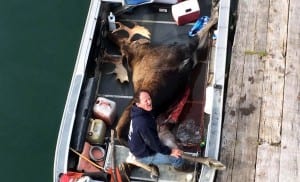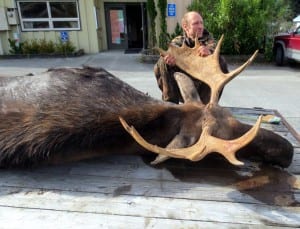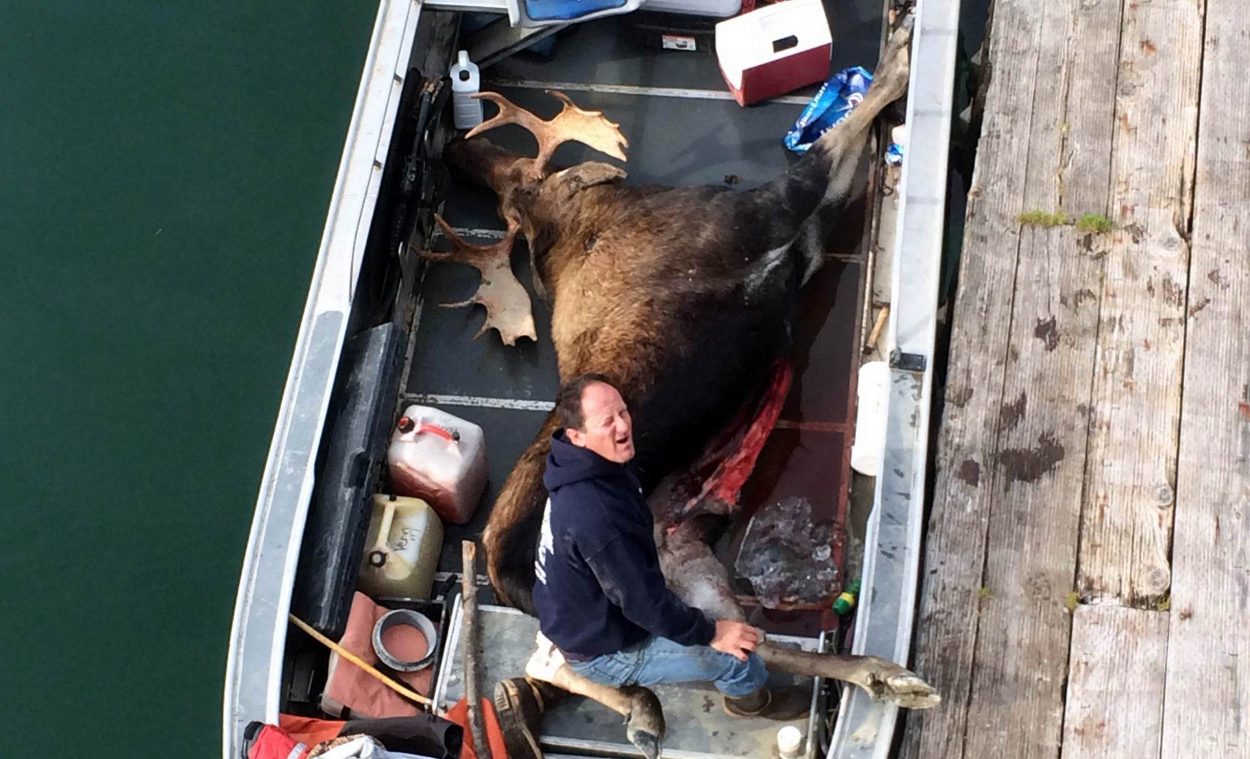
Greg Meissner of Wrangell brings in his moose at the Wrangell dock last week. Photo/Katarina Sostaric, KSTK
Compared to some other parts of the state, it’s not easy for hunters to get a moose in Central Southeast Alaska. For one, the forest is just everywhere.
Rich Lowell is the Area Wildlife Biologist for the Alaska Department of Fish and Game in Petersburg.
“We are not typical moose habitat here,” Lowell says. “We’re a coniferous forest, it’s dense. It makes it pretty difficult.”
Despite the challenge, there’s a great desire from local hunters to get a moose. And so far, this year is proving to be a bit better. The season opened September 15 and within the first week, 26 bulls were taken. The average for that week in the last five years is 21.
“It looks good,” says Lowell.
As a management biologist Lowell’s job is to keep the moose population healthy while giving hunters the best opportunity to fill their freezers. Hunting rules have changed over the years but more recently have hinged on antler restrictions. These restrictions have been the same since 2009 when managers began allowing hunters to take moose with two or more brow tines on both sides. By restricting antlers, managers can try to control the age of moose that are harvested.
Lowell says they want younger and older bulls to be taken but need to protect the middle aged ones, which are good for breeding.
“Our selected harvest strategy is intended to harvest bulls, start harvesting them at about six years of age so you are protecting bulls in that three to five year age class to do the breeding,” Lowell says.

Peter Baekkelund of Petersburg sits on his moose which was the first kill reported this season. It was taken at Falls Creek on Mitkof Island. Photo courtesy of Peter Baekkelund.
Lowell says using antler restrictions, instead of other management methods like hunting quotas, also allows them to include the moose’s rutting season without fear of over harvesting. The breeding time gives hunters an advantage when the bulls are more vulnerable.
“They’re running around a little crazy and love struck so they’re more susceptible to calling,” Lowell says.
Managing by antler restrictions is not a perfect science as some antlers are deformed or broken but it’s the best method managers have come up with since they’ve been keeping harvest records from the early 60s. It’s hard to say what the average harvest has been during that time because the restrictions have varied so much. As Lowell says, you’d be comparing apples to oranges. In the last five years, restrictions have been the same, and the hunt has averaged 88 bulls a year. Lowell says managing the population is more about trends.
“We watch carefully the harvest trends over time,” Lowell says. “We had initially thought that if we allowed hunters to harvest those bulls with two brow tines on both sides that we’d see the number of those animals decrease in the population from year to year but actually they’ve held pretty strong and it looks like it’s going to be sustainable.”
Hunters have five days from the time they catch a moose to the time they must report it at the state office. They are required to bring in the antlers and a five inch section of the lower jaw. This allows biologists to age the moose by pulling a tooth.
“And then we photograph the antlers and that allows us to build records of antler architecture over time and look at how it changes with age of the animal,” Lowell says.
Managers are after all the information they can get. Just as it’s not easy for hunters to get a moose in the region, managing their population is also tricky. Because the region is covered in dense forest, you just can’t see the moose to count them. Managers, like Lowell, have only one good place to do aerial surveys on a regular basis and that’s the Stikine River drainage.

Peter Baekkelund of Petersburg poses with his moose which was the first kill reported this season. It was taken at Falls Creek on Mitkof Island. Photo/ADF&G
“And the lower riparian area of the Stikine is dominated by cottonwood and so when those deciduous leaves fall off we can actually see moose if we get favorable snow conditions so that the moose stand out,” Lowell says. “So, really we don’t have a good population estimate for this area because we simply can’t count them.”
However, Lowell believes that, in general, harvest numbers are showing an increasing trend–an increase in both moose population and in the animals’ distribution across the Unit 3 islands.
As of September 23, the total harvest was 27 bulls. Of those, half were taken on the Stikine. The rest were spread out. Kupreanof Island had 5, mostly near Kake. Mitkof Island had three, Wrangell Island, two, Virginia Lake, one, Farragut Bay, one, and Port Houghton, one.
The season closes October 15.










